There is currently a drought in the Horn of Africa, including Somalia, northern Kenya and eastern Ethiopia. Some experts are saying it is the worst drought to hit Somalia… ever! Some have already died and the risk of famine is lurking – a famine we have averted so far through providing resources to the affected areas. The droughts are increasing in severity and frequency, but they might be manageable in the future. Before discussing strategies to manage drought, it is important to get a clear picture of the current crisis in Somalia.
Short description
5 rainy seasons in a row have now failed in the Horn of Africa region – especially in the Somali settlements of the region, and the effects are gruesome. A main contributor is climate change. The Horn of Africa is facing the worst of a global climate crisis, while almost having no influence (0.1%) in creating it. In Somalia, it is especially bad around the Bay and Bakool regions. Humanitarian organizations and the international community are doing a lot to help by mainly providing money to tackle the situation on the ground, but there is still a huge lack of resources. With the war in Ukraine and increasing food prices, help is harder to come by during this drought. The doctors treating the malnourished and hunger-hit families say they have never seen anything like it. There are plenty of numbers being mentioned to describe this drought, and despite occurring regularly, this drought is particularly bad.
So why do these droughts keep happening in Somalia? And why do they tend to get worse each time? Can we prevent it somehow or deal with it better and thereby save more people?
How bad is it?
The most recent (Nov, 2022) descriptive report I could find is a report by OCHA:
Somalia’s population is around 17 million. According to the report:
- 7.8 million Somalis are affected by the drought (this is 46% of the population)
- 6.7 million are experiencing drought-related malnutrition, and 6.4 million struggle with finding water.
- 1.8 million Somali children are acutely malnourished. Over 500.000 of the cases are severe.
- 3 million livestock animals are dead
- 1.27 million has left their homes due to the drought
- To fight it, there was a need of $1.8 Billion, of which $1.3 billion (72%) was collected for Somalia.
Can we please catch a break?!
The current drought, 2020-2023, begins just 3 years after the previous one ended. It came while the affected communities were dealing with the effects of:
- Extremely heavy rain leading to flooding in 2019
- Desert locust invasion in the late 2019
- Covid-19 and all its consequences on income-sources
- The war in Ukraine affecting economics and trade worldwide, which along with high inflation rates increased prices of oil and food.
- And lastly the violent conflicts and attacks going on continuously since the civil war, restricting free movement.
(For a full list of all the issues in Somalia, see the about section of the website here)
Which areas of Somalia are most affected?
Using the most recent data from OCHA, and the statistical program R (with spatial ggPlots) I was able to generate the two graphs below. The figures show that Baydhaba/Baidoa (Bay region) and surrounding districts are worst hit and are in “emergency” mode – indicated by malnutrition and use of emergency livelihood strategies. A graveyard in Baydhaba has already buried 230 children.
Coastal areas in Galguduud and Mudug, along with Burco are also in emergency mode. Interestingly, areas near Somalia’s main rivers are usually better off (right figure).
The common way to measure the effects of drought on food is using the Integrated Phase Classification which is divided into 5 phases. Phase 1: Minimal, Phase 2: Stressed, Phase 3: Crisis, Phase 4: Emergency, Phase 5: Famine. The IPC also has an official website. (More about the IPC later)
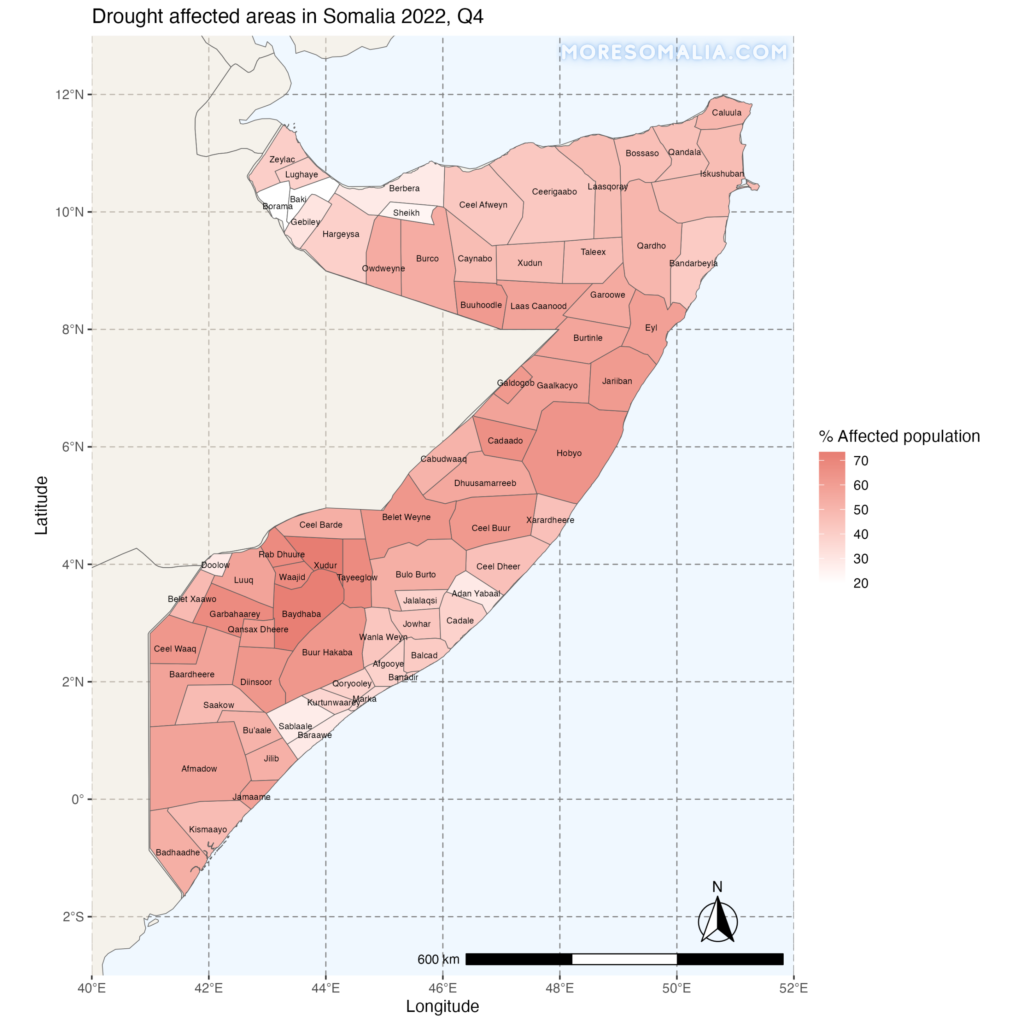
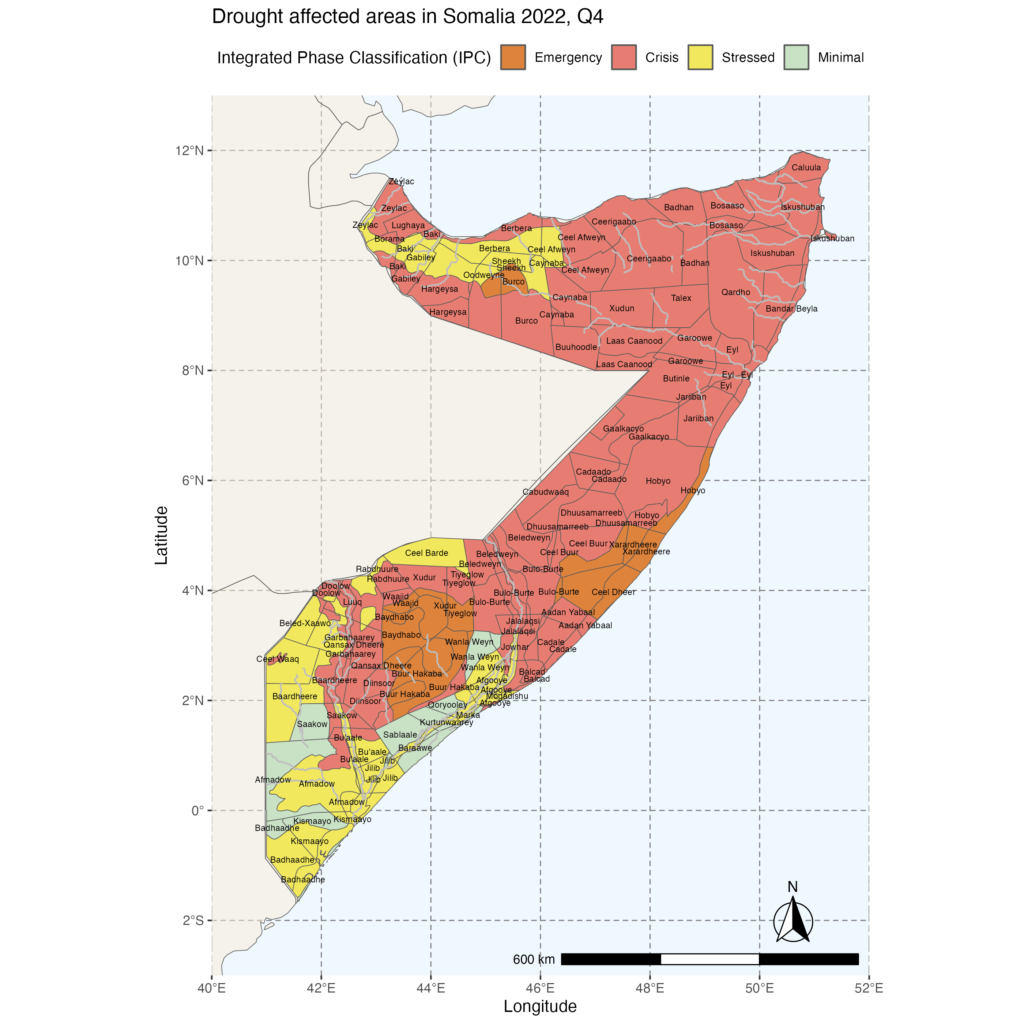
The suffering pastoralists
Somalia’s historical culture is that of the pastoral lifestyle. However with these droughts the livestock is dying off, and many are forced out of pastoralism. With more than 3 million livestock dead, lack of milk and meat have big consequences on nutrition. Over 72,000 pastoralist families have lost their capital in Garissa. It takes 5 years for a pastoralist family to rebuild after drought, but the droughts are increasing in frequency and intensity.
The issues, point-by-point
To look more detailed at the effects, here is a summary of the different categories described in the OCHA report:
Water: 6.4 million Somalis are lack access to water for drinking, cooking, cleaning, or sanitation. As the water sources have dried up, many water borne diseases and infections are on the rise. The women and girls fetching water have to walk 2-3 times longer, which puts them at risk for violence and dehydration.
Diseases: 12,000 cholera outbreaks were observed in 2022 (January-October) in Somalia. Measles are also increasing. With malnutrition, the health is affected, making especially children and pregnant women less able to fight against diseases.
Food: With increasing food prices, some are forced to choose between paying for food or medicine.
Displacement is when people are leaving their homes, and already 1.27 people in Somalia has left their homes (around 7.5% of the nations population). They are both going to near-by towns or crossing the borders. Over 15,000 and 20,000 Somalis sought asylum in Ethiopia and Kenya, respectively, in 2022 due to the drought.
Education: Somalia is in dire need of better access to education, but issues such as these droughts disrupt the process. In this case, 400,000 children have lost access to education, and another 900,000 are at risk. E.g. lack of easy water access requires more hands to take care of the cattle.
Exploitation and abuse of women and children. Over 80% of older people are sacrificing their meals for the average of 5 children they take care of, while the younger ones are travelling in search of food, and work for money.
What is the mechanism behind drought?
This is the part where it gets very interesting and technical. Drought is a period of time with deficiency of rainfall leading to water shortage. It can exist from days to decades, and it is often impossible to pinpoint exactly when a drought has begun, and afterwards, exactly when they ended. Interestingly it is described as the second-most costly weather event, following hurricanes. There are different types of drought as described below, and the impacts can be measured by sectors.
Droughts typically begin as meteorological droughts, with lack of rainfall.
Then comes the hydrological drought which impacts the water reservoirs and lakes.
Finally agricultural or ecological droughts occur affecting crops and the entire ecosystem.
Worldwide, droughts are becoming more extreme and difficult to predict due to climate change, with developing nations being the most affected.
The “La Niña” effect
The current drought is partially the result of the La Niña effect – a natural weather phenomenon in the Pacific ocean. It impacts the world’s weather patterns and ocean temperatures, thereby affecting societies around the world.
Currently we have a rare “triple dip La Niña“, meaning three La Niñas three years in a row, which causes droughts and floods around the world. This has not happened since 1950.
La Niña means “little girl” in Spanish, and the opposite phenomenon is called “El Niño” (“little boy”). La Niña happens every 2-7 years, while El Niño occurs every 2-4 years. A great video explaining the phenomenon is here.
- La Niña takes place in the pacific ocean, where extra strong winds push a lot of hot surface water towards the west (East asia and Australia). This causes the hot water to evaporate, turn into rain and often floods in that region.
- Meanwhile in the east, the cold ocean water near South America is pushed to the surface, and here droughts and dry conditions is seen.
The regions affected by La Niña are typically 1) Droughts in East Africa, Southern USA, and Europe (which experienced highest temperatures this past summer), and 2) Floodings in Australia, Indonesia, West Africa-central Africa, Northern USA.

In Somalia, this means that the eastern winds, which usually provides moisture are reduced – which means rainfall is reduced. On top of this, due to climate change the rising temperatures in the Indian Ocean pulls moisture away from East Africa, reducing the moisture.
Looking at the graph above, you can see all the La Niñas at the bottom of the graphs, which coincides with the past severe droughts in Somalia. The opposite peaks show El Niños.
You may also wonder what that big La Niña dip is at 1999-2001. It is indeed showing the drought of 1999. Previous droughts include the ones in 2005–2006, 1987-1988, 1974, and 1969.
The Indian Ocean Dipole
This is basically La Niña, but in the Indian ocean closer to Somalia, instead of in the Pacific. Often times, following a La Niña is a negative “Indian Ocean Dipole” (IOD), which contributes to the below-average temperatures in the waters of East Africa, leading to less rainfall.
The Indian Ocean Dipole is conceptually similar to La Niña. It is just a climate pattern in the Indian Ocean that is characterized by a difference in sea surface temperature between the western and eastern parts of the ocean. The IOD can be positive, negative or neutral.

A negative IOD event occurs when the ocean surface temperature in the western Indian Ocean (near Somalia) is cooler than in the eastern part of the Indian Ocean. This can lead to reduced rainfall in the Somalia. During the flood in the end of 2019, the opposite was seen – peak positive Indian Ocean Dipole (big red peak on the graph).
As you can see in the graph, every major negative IOP coincides with one of the three last droughts in Somalia.
A more detailed breakdown of these weather phenomena along with predictions for the drought can be found here (AgriLinks).
A comparison of the last 3 droughts in Somalia
In recent years there have been 3 severe droughts hitting Somalia:
| The 2011 East-African drought: | The 2016-2017 drought in Somalia | The 2021- drought in Somalia |
|---|---|---|
| Duration: Summer 2011 to summer 2012 Deaths: up to 250,000 (BBC) to 260,000 – half of those were under 5 years old. Why?: Irregular rainfall, high food prices, poor harvest, La Niña Famine?: Yes, declared 20 July 2011 by the UN Relief: $1.3 Billion | Duration: End of 2016 – most of 2017 Deaths: 1.100 deaths (Low number, due to early response) Why?: Instability, Climate change, El Niño, Negative IOD Famine?: No. Averted due to fast humanitarian efforts | Start: End of 2020/beginning of 2021 Deaths: 730 children so far, 500,000 currently at risk. Relief: $1.5 Billion (67% of the $2.3 Billion needed) Cause: La Niña, negative IOD, instability Severity: The people refer to this as the most severe drought of the three. |
The rainy seasons and when they fail

There are 2 rainy seasons in Somalia. The “long rains” which is main rainy season (aka “Gu“) occurring between March-May, while the “short rains” (aka “Deyr“) occurs between October-December.
The long rains are responsible for 75 percent of the rainfall, while the rest falls during the short rains. A missed rainy season refers to lower than average rainfall during either one of these rainy seasons. Interestingly some of the smaller rivers are only filled with water during these rainy season.
If you look at the last 3 droughts in Somalia, the current one is the longest with 5 missed rainy seasons. The Mar-May 2022 rainy season was reported to be the driest in 70 years!
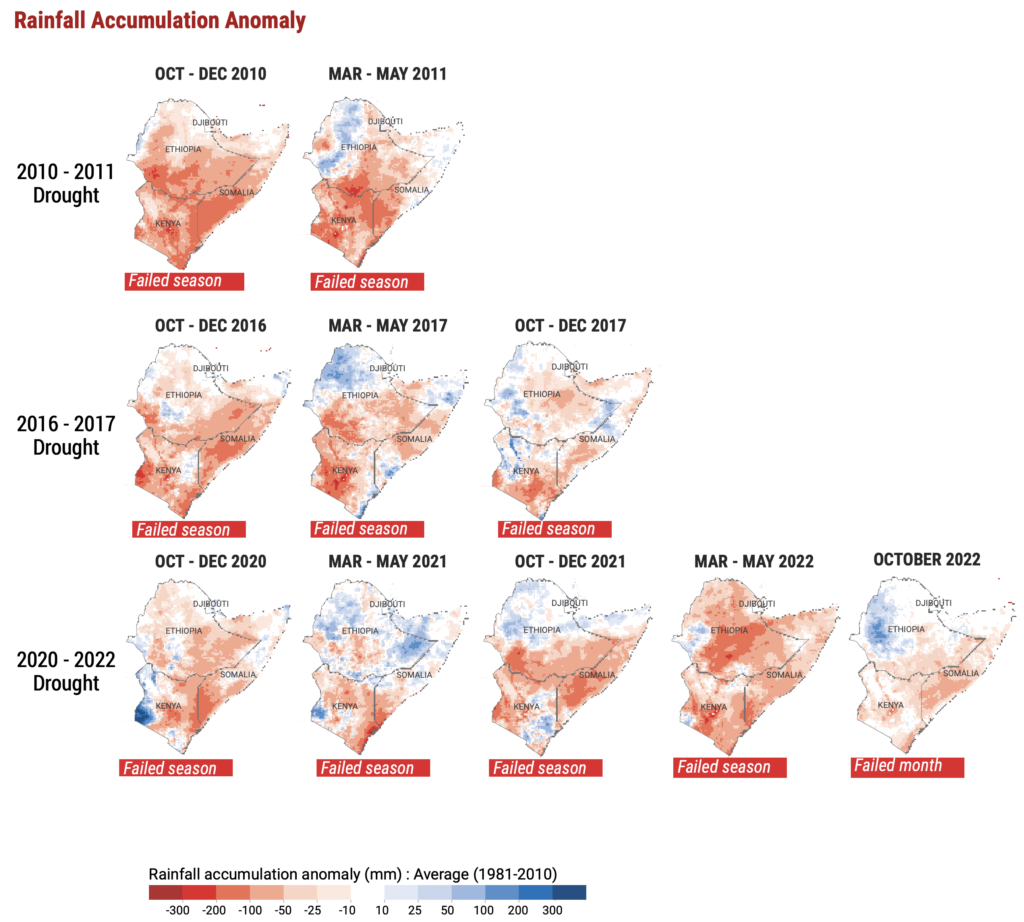
Who’s helping during this drought?
Humanitarian officials learned from the late response in the drought of 2011, and went in to help early. The Somali government declared drought in April 2021 during the 2nd failed rainy season. According to recent numbers, there are at 319 humanitarian organizations in Somalia for drought purposes (248 of which are national NGOs).
How many people have gotten assistance? Around 86% of those needing help have been reached, which percentagewise is much higher than Ethiopian and Kenyan drought affected areas. The funds go to different sectors, and among the least supported is child protection and gender violence (under 10% reach) while the most funded is Food security and nutrition as expected. Lack of funding is one of the reasons for the response struggle.
An unfortunate circumstance is access; The challenges of getting the aid to the people needing it.
- Security issues: Hard-to-reach areas of Somalia are in part due to the Al-Shabaab vs Government clashes (particularly Hirshabelle and Galmudug regions). A way to mitigate this is by working with local communities and authorities for better reach.
- Violence is also seen in Oromia and the Somali Region of Ethiopia impacting key routes.
- Lack of infrastructure in the southern Somalia is another challenge for aid transportation.
The 2011 drought led to famine. It was a particularly bad one due to restricted access (Al-Shabaab blocking humanitarian aid). The next drought in 2016-2017, brought the country to the brink of famine, but it was prevented by early response. The current one started just 3 years after the previous one ended. The unfortunate pattern is: increasing frequency.
Funding
The UN based Somalia Humanitarian fund gave $13.3M in the month before the government declared drought in April 2021. Anther UN fund (CERF, ’emergency response’) followed with $27M. More have followed since then, and humanitarian aid has increased even more in 2022. In Somalia, 86% of the people targeted for was reached by the humanitarian organizations – the highest number between the 3 countries. Despite the reach, there is still a lack of resources due to underfunding. Currently, Somalia has received $1.5 bn of the $2.3 bn needed.
What are they funding exactly during drought response?
- Camps to house and provide protection to displaced people (called CCCM)
- Health and Nutrition
- Food and livelihoods (cash payments or ‘in-kind transfers’ such as vouchers)
- Education
- Protection for all; including children and against gender-based violence
- Water for drinking, sanitation, and hygiene
- Housing and land
Why isn’t the government officially declaring famine?
When it comes to famine, you should know about the Integrated Phase Classification (IPC)
The IPC was developed in Somalia in 2004, due to the need for an evidence-based way of classifying food security in order to facilitate good humanitarian response. It is an agreed-upon method to measure lack of food and malnutrition. Today, it is used in over 30 countries. According to the IPC, famine is simply defined as “an extreme deprivation of food”.
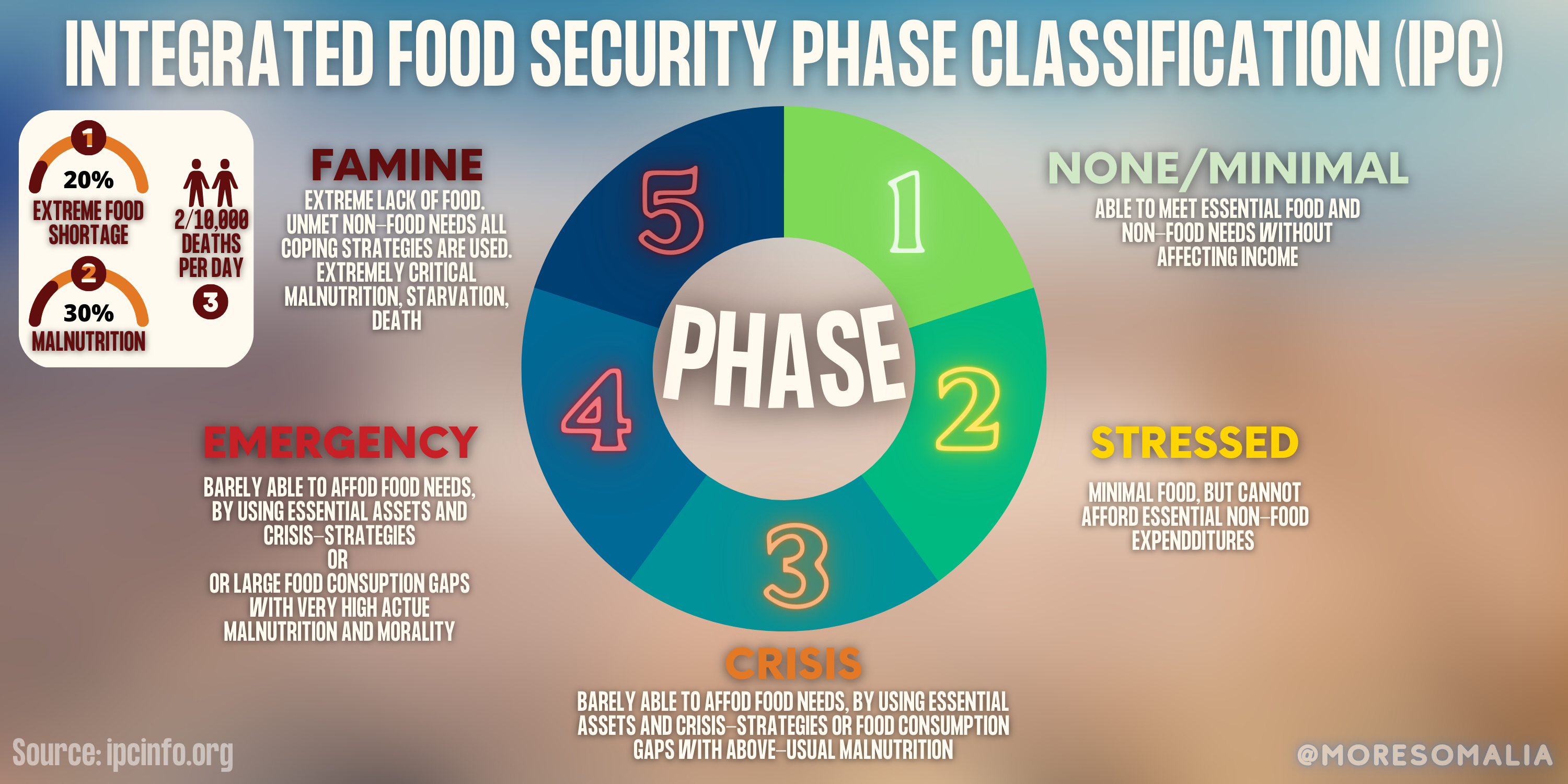
What does it take to declare Famine?
As seen in the left corner of the image, the criteria for the declaration of Famine in an area according to the IPC is:
- Acute malnutrition of at least 30%,
- Extreme food shortages for 20% of households (access to less than 2100 Kcal), and
- At least 2 of 10,000 people die each day.
Even if all the criteria was met, it is not the job of the IPC to declare famine – the IPC can only classify “famine”. The declaration of famine is the responsibility of governmental and UN agencies.
In a recent interview with Al-Jazeera (december 2022), president Hassan Sheikh Mohamud said that the first thing he did once elected was to focus on the drought victims by raising awareness in the international community. He says this is why Somalia averted the famine which many tried to predict would happen. He also mentioned, that the drought is 1 of his 3 top priorities right now, but the risk of famine is not there right now.
Regardless, as we learned in the drought of 2011, waiting for a declaration of Famine by the Somali government in order to help is not a good idea. Action must be taken early, not after we declare the situation is bad enough. In the 2011 drought, half of the 260,000 people who died due to the drought, lost their life before the official declaration of famine. It showed the importance of acting fast and getting ahead of the catastrophe, and fast action has shown effective both in the drought of 2016-2017 and the current one from 2021.
In perspective
Humanitarian organizations are of course prioritizing the hardest-hit regions first to avoid further catastrophe, however as the drought continues, other regions are also suffering, deepening the crisis. Without enough funding, it will be impossible to prevent further deterioration and we will continue to play catch up. The drought has now continued into 2023, as we wait for the 6th rainy season. However, projections already expect it likely to perform below average. This is the worst drought in recent history, and the goal is simple: prevent famine. A large contributor is climate change, which Somalia has not really contributed to, so it is important that the world supports while we can still act and prevent the catastrophes and famines we saw a decade ago.
Agriculture takes a hard hit during droughts. In the USA there was a loss of over $20bn in 2022 due to the drought – but farmers around the world are suffering. Entire kingdoms have fallen due to drought. The pastoral life will only get more difficult, as weather phenomenon becomes more extreme around the world. Alternative lifestyles or innovative solutions are needed for the pastoral families in East Africa.
It may seem paradoxical: Somalia has the largest coastline in mainland Africa with access to the Indian ocean, but despite this it is regularly suffering from drought. As paradoxical as it may sound though, access to salty sea-water does not currently prevent drought and need for rainfall. But maybe we can still use it?
Is drought preventable or manageable?
Yes. Somalia is not the only place to experience drought. It is not the driest patch of land either. We can use our current technologies to prepare better for the next drought. We can use our innovation to build on existing technologies. Or we can develop new methods for managing it better in the future. In the next upcoming posts we will dive into drought management and solutions as a series. These will include: Water conservation, Desalination of seawater, tree planting against deforestation, cloud seeding, dam building, groundwater drilling, agricultural solutions etc.
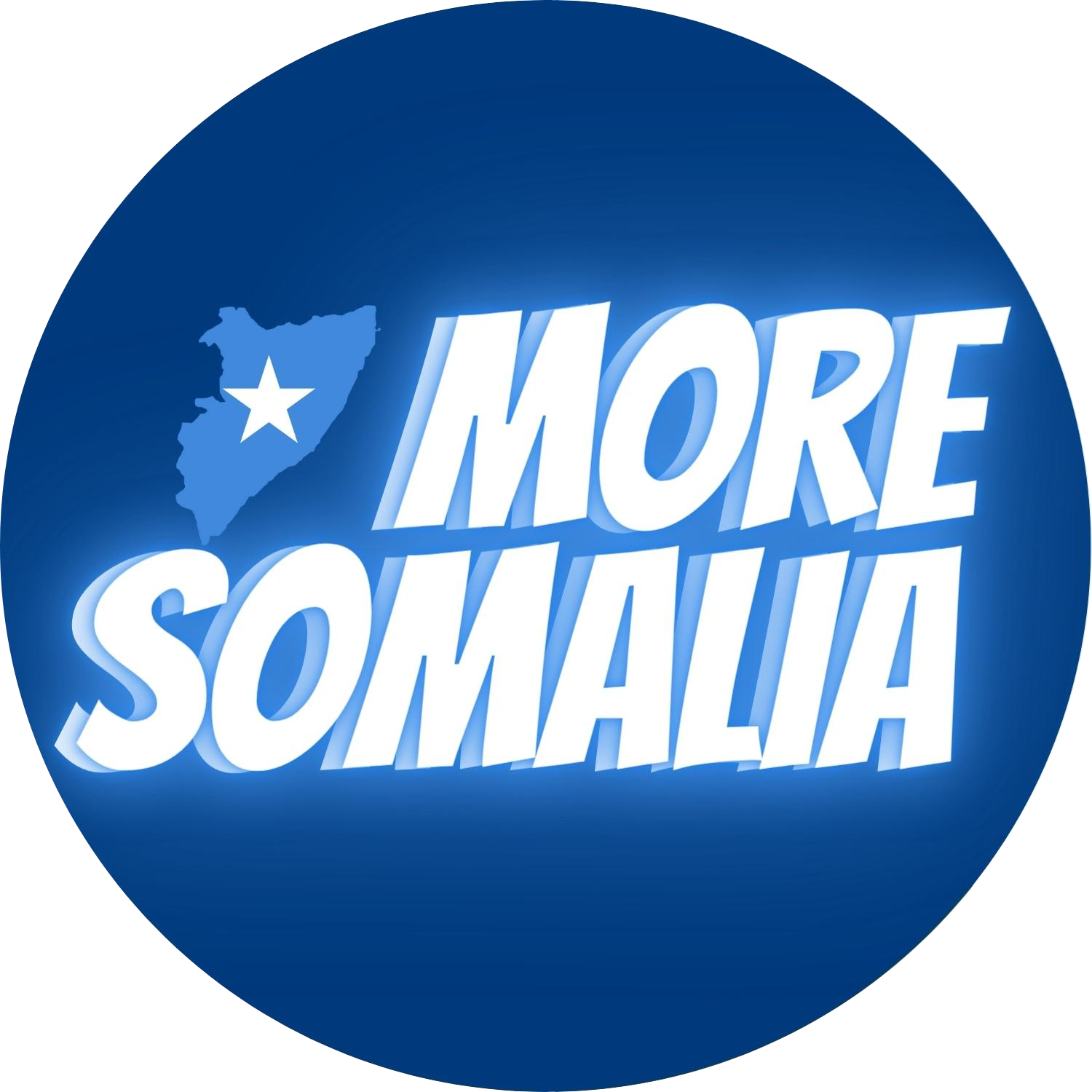
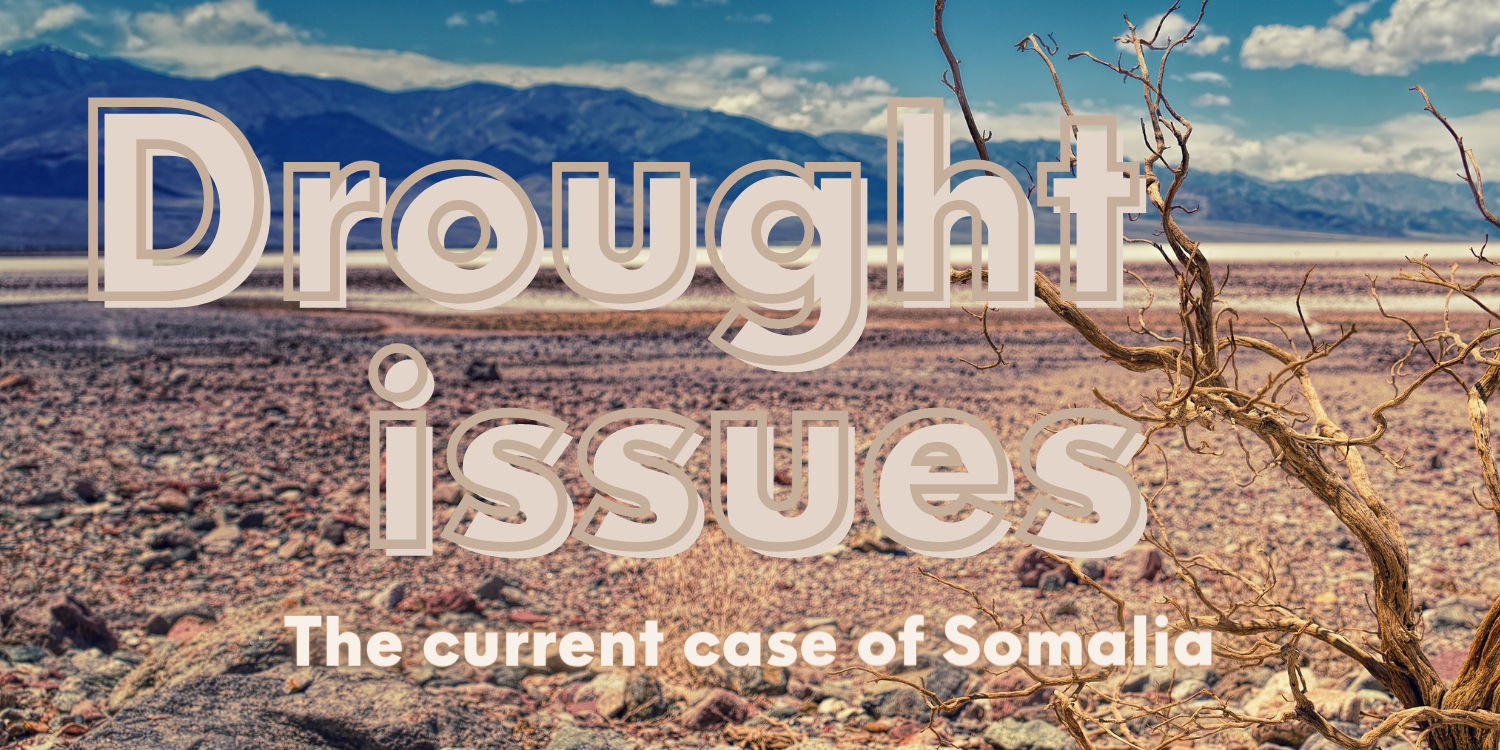

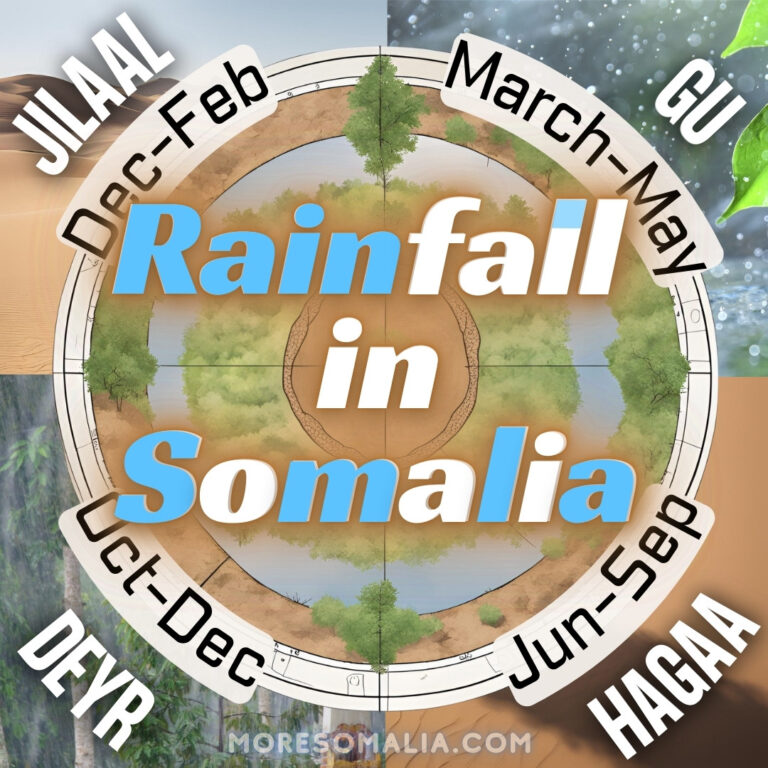
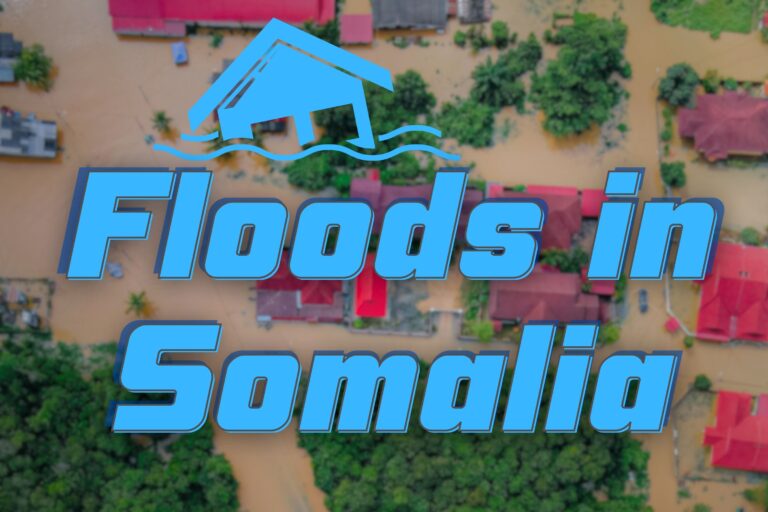
[…] the previous post we covered the drought in Somalia including its causes and teased a few of the solutions. Today we will explore one of those – […]
[…] The weather phenomena behind both droughts and floods in Somalia are called La niña and the Indian Ocean dipole (I explained most of it here). […]
[…] populations. This increased food imports and aid dependence as seen the case during the severe drought of 2017 where humanitarian aid played a crucial role in improving […]
[…] 43000 deaths could possible be attributed to the drought. We wrote an entire article about the drought in Somalia here, and showed it was the longest drought in centuries. As we consider drought to be among the worst […]
[…] sources and displaced people, setting the stage for widespread cholera outbreaks. For instance, severe droughts, like the one in 2017, forced people to rely on unsafe water sources, exacerbating the crisis. In 2017 alone, about […]